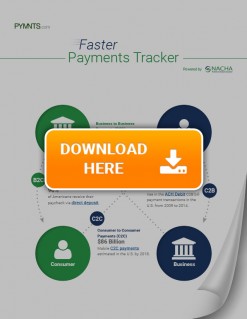Coming Together To Bring Faster Payments To Life

The world is getting faster, and payments are trying to keep up. In this month’s Faster Payments Tracker™, PYMNTS spoke with Steve Ledford, TCH’s Senior Vice President for Product and Strategy, and Russ Waterhouse, TCH’s Executive Vice President for Product Development and Strategy, about their recent submission to the Fed’s Faster Payments Task Force, the search for ubiquity and what’s next for same-day payments.
When The Clearing House (TCH), the payments firm owned by commercial banks, along with global software and services provider FIS, recently submitted their proposal to the Fed’s Faster Payments Task Force in order to evaluate their real-time payments system proposal, it signified a milestone along the path toward real-time payments.
The implications of the joint proposal, as it turns out, go beyond the solution itself. According to TCH, the milestone toward a complete solution indicates an industry acknowledgement that partnerships and collaboration among providers is recognized as productive toward satisfying the Faster Payments Task Force’s established effectiveness criteria, which ultimately were designed with an end-to-end solution in mind.
On the heels of the announcement of the proposal submission, PYMNTS caught up with Steve Ledford, TCH’s Senior Vice President for Product and Strategy, and Russ Waterhouse, TCH’s Executive Vice President for Product Development and Strategy, who described the partnership with FIS as an important step toward their goal of a new set of real-time payments rails with ubiquity. FIS has 3,000 financial institution relationships, which, when combined with those from TCH partners Jack Henry and D&H, gives TCH the potential to reach more than 10,000 financial institutions – something that both Ledford and Waterhouse acknowledge is critical to its success.
Ledford and Waterhouse also acknowledged that collaboration with players including Early Warning System and clearXchange (acquired by Early Warning last October) – industry competitors – is an essential part of bringing real-time payments to fruition – work that complements rather than competes with TCH’s vision to enable faster, and better payments for people and businesses.
Thinking it through – getting from here to there…
Ledford and Waterhouse agreed that what makes the U.S. real-time initiative different than others that have preceded it is that those were driven by regulatory mandate. So, not only is TCH is hoping to learn from those who have gone down the faster payments road before them, but also they recognize that the system has to deliver significant value to participating banks. This means keeping a close eye on faster payments developments around the world.
“If you look elsewhere in the world, and I don’t know if there’s an exception to this, it’s all been forged by mandate,” Waterhouse said. “And as a consequence of that, I think the banks have said, ‘OK, I have to do it,’ and in some cases have put in the limited solution, which is whatever the minimum requirement was to kind of pass the hurdle.”
However, because the arrival of real-time payments in the U.S. was not brought about by a mandate, TCH has focused on how the solution must be attractive to banks and customers, Waterhouse said.
“We’ve tried to be very thoughtful about the designs, make sure it’s economically viable, make sure it actually does meet the needs of banks and their customers to compete going forward,” he said. “That’s something we’ve taken a keen interest in, to make sure it really does deliver value. As you look at the design and the system, I think it stands apart from anything else that’s been implemented in the world in that regard.“
Ubiquity, ubiquity, ubiquity
For its real-time pilot program, TCH is focused on bill payment as its first use case. One driving reason, Ledford said, “is that bill payment is one of those applications where you can do something meaningful, even while you’re ramping up to ubiquity.”
By getting major billers, such as wireless providers and utility companies, on board, he said, customers can get used to paying regular, recurring bills through their banks. Once billers are represented, it’s up to the banks themselves to provide a positive customer experience, he said.
Banks will ensure customers can pay their bills securely, conveniently and quickly, while on the other end, service providers must be able to accept payments just as easily. If the direct bill presentment process through the bank channel is compelling, Waterhouse said, it will create an opportunity for payees and billers to move away from biller-hosted payment sites.
“That’s what we’re really looking for – how can we change the bill payment experience so it really works for everybody,” Ledford said.
The ultimate goal, Waterhouse said, is ubiquity – namely, to make real-time payments mainstream.
“We clearly understand and recognize that, for this to work, it’s got to be ubiquitous like an ACH or check is,” Waterhouse said. “But it’s also got to bring value that’s way beyond just delivering money quickly. And that’s why, you think about the design and the approach that Steve [Ledford] and the team have taken, it’s not just about the speed — it’s about the full function of the system, in terms of what it provides to the banks in terms of a development platform. There are a lot of non-payment messaging capabilities that we think will provide tremendous opportunity for innovation.”
And the “delivering value” piece is not to be underestimated in the pursuit of ubiquity. TCH recognizes that having access to 10,000+ banks is different than having connectivity to 10,000 banks. Crossing that chasm is a function of making sure that the value is there for both the receiving and originating banks, and that the economic proposition makes sense. The biggest fear that all banks have in the move to faster payments is the cannibalization of existing revenue streams, coming at the same time banks are under tremendous competitive pressure to make the move to digital.
As a result, Waterhouse said that TCH has a framework for a system that would work for as many stakeholders as possible to reach all financial institutions.
“It brought a lot of folks together who wouldn’t have otherwise,” Ledford added.
Real-time payments – all hands on deck – clasped together
Waterhouse emphasized that since TCH “represents the largest banks in the U.S.,” it believes it is well-positioned to provide “the unifying standard and that unifying design” which will give people confidence in the new systems. But not without help.
When it comes to the importance of partners and collaborators, Ledford said, “If you look at the scope and breadth of what the task force is looking for, it’s clear that real-time payments is not just a system – I don’t think any one system would be a complete solution.” He added, “When you look at the initiation of payments all the way to the end, all the elements — the clearing, the settlement, the security — it’s going to take partnerships to satisfy all those pieces.”
“We see the efforts of EWS/cXc and TCH as complimentary, their focus is first and foremost on enhancing the consumer experience of banks P2P offering, which is a highly competitive space for all banks. In this they lever core capabilities around IDV/security, directory, a common, easy and safer consumer experience with real time availability. Final clearing and settlement is happening over ACH. It’s possible that once our real time system is up, and available, they can leverage the real time rails, migrate that volume over from ACH.”
Ledford said that when it comes to competing sets of rails, “there’s a lot of crossover investment” banks can take advantage of. The primary cost, he said, isn’t really connecting to different rails, “the cost is mostly with what you have to do in your own applications, your own customer experience, online banking payments, that type of thing.”
And it is the solution itself that takes priority. “The attributes of what is being designed, we believe, are kind of fully in the interest of all banks and should be embraced by all banks,” Waterhouse said.
Stay tuned for the next installment from the faster payments frontlines. Things are starting to move, well, fast…
To download the May edition of the PYMNTS.com Faster Payments TrackerTM, powered by NACHA, click the button below …
About The Tracker
The PYMNTS Faster Payments Tracker™, powered by NACHA, is your go-to resource for staying up to date on a month-by-month basis. The tracker highlights the contribution of different stakeholders, including institutions and technology coming together to make this happen.

